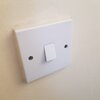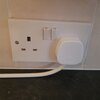I remember as a young lad working on a farm, I got a belt off the light switch when I came to use it, at which the farmer said that's why I wear a cap and flicked the switch with his cap, it never gave him a shock only visitors.
Safety is not simply following regulations, it is also down to taking steps not to put your self in harms way, but to follow the regulations you need to test and inspect every alteration you make and complete the minor works certificate or installation certificate, it is clear DIY people in the main don't do that, so being blunt DIY people don't care about regulations and often don't really worry about personal safety, if they did they would simply never fit metal switches or sockets.
I agree there is little the DIY man can safely do with a switch change other than touch with neon screwdriver to see if live, however also talking about changing a socket, and line and neutral terminals are not always in the same place, may seem odd but the electrician is more likely to make an error, I remember fitting a number of boxes of sockets, most had line to right but one had line to left, I missed it, so fitted them with line and neutral swapped, however since I always tested I realised my error and corrected, but it is easy to make an error, and it is so easy to plug in a tester and see error before there is any problems as a result.
Line and neutral swap means line not fused, and item can be live when switched off, but item still works, so unless tested it can go undetected for years, my old house doing a test I found ring final broken, easy enough to miss causing over loading, but everything works, so again unless tested can go undetected for years.
However the question is can we really ask or expect the DIY man to test. Personally I would not like to tell a DIY man to open a consumer unit, and not sure I could explain how to test wires at the socket in an unambiguous way to ensure all was OK, I tend to use the loop impedance tester, if ring lost with line or neutral the impedance will rise, so before, during, and after testing will show all wires connected, but how many DIY people have a loop impedance tester?
However to simply say get an electrician to do it, kind of removed the whole point of a DIY electrical forum.
We all break the rules, I may run across the road rather than wait for larger break in traffic, although not so often at my age, but although you may run across the road, you would not train your children to run across the road.
So in a modern house with RCD protection on every circuit for the DIY guy to switch switches and sockets is not really much of a problem, a neon screwdriver and plug in tested is likely enough to protect them, but in an old house with re-wireable fuses and no RCD the danger is much increased, having lived in a house with full RCD protection for last 25 years I tend to forget some house don't have that protection, there are not many pre-1966 installations left with no earth on lights, but there are some.
And with DIY there are many lighting systems where 12 volt has been converted to 230 volt and has resulted in no earth to light fittings, when I moved in here there was a large notice on the consumer unit test RCD regular, and I thought good at least sockets are RCD protected, however I was wrong about a dozen were protected, but most of the house was still using re-wireable fuses, of course now all RCD protected, but had some one taken a photo of that old consumer unit and posted it on this forum asking if RCD protected sockets I would have said yes. Until switching off consumer unit did not cause power to fail I had no idea there was a fuse box hidden in the ceiling.
So how far can we go spouting regulations? To my mind you need to forget regulations and try and give some advice as to safe working practice, the neon screwdriver has become a dirty word, however working in the tunnel in Hong Kong it was our life belt, or maybe anti-belt device, tested all metal before touching, yes before working we should prove dead, and we should use a clamp on ammeter to test for borrowed neutrals before disconnecting a wire, but how many DIY people have a clamp on ammeter, they however much we frown on it, rely on the neon screwdriver to keep them relatively safe. Even if it does not comply with regulations.





